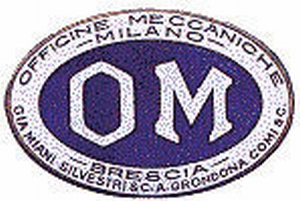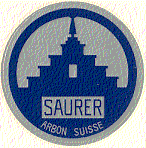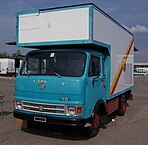IVECO, an acronym for Industrial Vehicles Corporation, is a Dutch multinational transport vehicle manufacturing company. It designs and builds light, medium, and heavy commercial vehicles. The name IVECO first appeared in 1975 after a merger of Italian, French, and German brands. Its production plants are in Europe, China, Russia, Australia and Latin America and it has about 5,000 sales and service outlets in over 160 countries. The worldwide output of the company amounts to around 150,000 commercial vehicles with a turnover of about €10 billion.

Officine Meccaniche or OM was an Italian car and truck manufacturing company. It was founded in 1899 in Milan as Società Anonima Officine Meccaniche to manufacture railway rolling stock and car production began in 1918. It disappeared as such in 1975, subsumed into Iveco, but still exists as a forklift builder.

Pegaso was a Spanish manufacturer of trucks, buses, tractors, armored vehicles, and, for a while, to train apprentices, and have a good brand image, some sports cars. The parent company, Enasa, was created in 1946 and based in the old Hispano-Suiza factory, under the direction of the renowned automotive engineer Wifredo Ricart. In 1990, Iveco took over Enasa, and the Pegaso name became a secondary brand of Iveco.

Unic was a French manufacturer founded in 1905, and active as an automobile producer until July 1938. After this the company continued to produce commercial vehicles, retaining its independence for a further fourteen years before being purchased in 1952 by Henri Pigozzi, who was keen to develop Unic as a commercial vehicle arm of the then flourishing Simca business.

The Fiat Ducato is a light commercial vehicle jointly developed by FCA Italy and PSA Group, and mainly manufactured by Sevel, a joint venture between the two companies since 1981. It has also been sold as the Citroën C25, Peugeot J5, Alfa Romeo AR6 and Talbot Express and later as the Fiat Ducato, Citroën Jumper, and Peugeot Boxer, from 1994 onwards. It entered the North American market as the Ram ProMaster in May 2014 for the 2015 model year.

The Renault Master is a large van produced by the French manufacturer Renault since 1980, now in its third generation. It replaced the earlier Renault Super Goélette light trucks. Opel has sold versions of the second and third series vans as the Opel Movano in Continental Europe and Vauxhall Movano in the United Kingdom. All three generations have been designed and manufactured by Renault, irrespective of the brand.

Seddon Atkinson Vehicles Limited, a manufacturer of large goods vehicles based in Oldham, Greater Manchester, England, was formed after the acquisition in 1970 of Atkinson Vehicles Limited of Preston by Seddon Diesel Vehicles Limited of Oldham. In 1974, the firm was acquired by International Harvester, which sold it in March 1984 to the Spanish group Enasa which made it a subsidiary of Pegaso. In 1990, it became part of Iveco which used the brand for various types of specialised vehicles in the United Kingdom. The range of models produced included EuroMover, Pacer and Strato, which are aimed at refuse collection, recycling and construction operators.

The Datsun Truck is a compact pickup truck made by Nissan in Japan from 1955 through 1997. It was originally sold under the Datsun brand, but this was switched to Nissan in 1983. It was replaced in 1997 by the Frontier and Navara. In Japan, it was sold only in Nissan Bluebird Store locations.

The Isuzu Elf is a medium duty truck produced by Isuzu since 1959. Outside Japan it is known as N series and Q Series. The range was originally mainly available in Japan and other Asian countries. Australia was another important market for the Elf and N series – to the extent that it was manufactured there from the 1970s using many local components. Since the early 1980s, it has also been sold and built in the United States, and also as the Isuzu N-Series. Only North America receives the wide-cab version competing against the Avia D90/D120, Hino Dutro, Hyundai Mighty, Iveco Daily, Mazda Titan, Mercedes-Benz Vario, Mitsubishi Fuso Canter, Nissan Atlas, Renault Trucks D, Tata LPT 613, Toyota Dyna and the GAZ Valdai.

The Isuzu Faster is a pickup truck that was manufactured and marketed by Isuzu between 1972 and 2002 over three generations. The Faster was succeeded worldwide by Isuzu D-Max, except in North America.

The Iveco Daily is a large light commercial van produced by the Italian automaker Iveco since 1978; it was also sold as the Fiat Daily by Fiat until 1983. Unlike the more car-like unibody Fiat Ducato, the Daily uses a separate ladder frame typical of heavier commercial vehicles. The Iveco Daily is produced at the Iveco Suzzara plant, near Mantova in Italy, where Iveco has recently made substantial investments to renew the production lines.

Adolph Saurer AG was a Swiss manufacturer of embroidery and textile machines, trucks and buses under the Saurer and Berna brand names. Based in Arbon, Switzerland, the firm was active between 1903 and 1982. Their vehicles were widely used across mainland Europe, particularly in the interwar period.

The Alfa Romeo Romeo was a light commercial, cabover van and pickup truck that was introduced by the Italian automaker Alfa Romeo in 1954 as the Alfa Romeo Autotutto. The line of vans continued to be built until 1983, when it was replaced by relabelled Fiat and Iveco commercials.
The Nissan Caball is a light commercial truck manufactured by Nissan Motors from December 1957 until December 1981. The Caball was mainly sold in Japan, Hong Kong, South East Asian countries, Australia, New Zealand, and few European countries and shared the Nissan Junior platform. While the Caball name came to an end in 1981 with the cancellation of the Junior, its larger replacement received the Nissan Atlas name in the domestic Japanese market. These are 2-4 ton trucks, the lighter versions in the Atlas truck range took over after the lesser Cabstar/Homer. In Japan, it was available at Nissan Store locations and replaced by the Nissan Atlas.

The "New Generation“ is a series of trucks by Daimler-Benz built from 1973 to 1988. It was then replaced by the Mercedes-Benz SK series. With the "New Generation", Daimler-Benz expanded its market position in the medium and heavy truck segments. Its cab was also used by Mercedes-Benz of North America, who confusingly offered it with inline-six or -five engines as the LP series beginning in 1985.

Zastava Automobiles was a Serbian international car manufacturer, a subsidiary of Group Zastava Vehicles which went bankrupt in May 2017.

The Iveco Zeta is a light to medium-duty truck model produced by the Italian manufacturer Iveco. Appearing in 1976 and entering production in 1977, its cab was developed with the aid of Fiat's wind tunnel in Orbassano. The Zeta series continued the lineage begun with the 1959 introduction of the OM Lupetto. The Lupetto, as well as the Leoncino, the Daino, and the Tigrotto, were all replaced by the OM X-series in 1972, which then formed the basis for the Zeta range. The Zeta itself was replaced by the all-new Iveco Eurocargo in 1991.

The Iveco T-series is a medium to heavy-duty truck model produced by the Italian manufacturer Iveco, although it used the squared-off H-series cab originally introduced by Fiat in 1970. The truck was badged as an Iveco Fiat from 1975 and by 1980 the "Fiat" portion had been dropped entirely. A lighter duty range called the M-series was added in mid-1984, replacing the long defunct Fiat 130NC.

The Iveco EuroCargo is a range of medium-duty trucks produced by the Italian manufacturer Iveco since 1991. The EuroCargo replaced the Zeta model produced in the 1970s.

The Ford FK, short for "Ford Köln," is a series of medium-duty trucks built by Ford of Germany in their Cologne (Köln) plant in two generations from 1951 until 1961. The Ford "Köln" name replaced the earlier Rhein and Ruhr badges as competitor Krupp (Südwerke) had quietly copyrighted them. Ford Germany withdrew from the truck sector after 1961, focusing on lighter utility vehicles and imports from Ford UK.




















